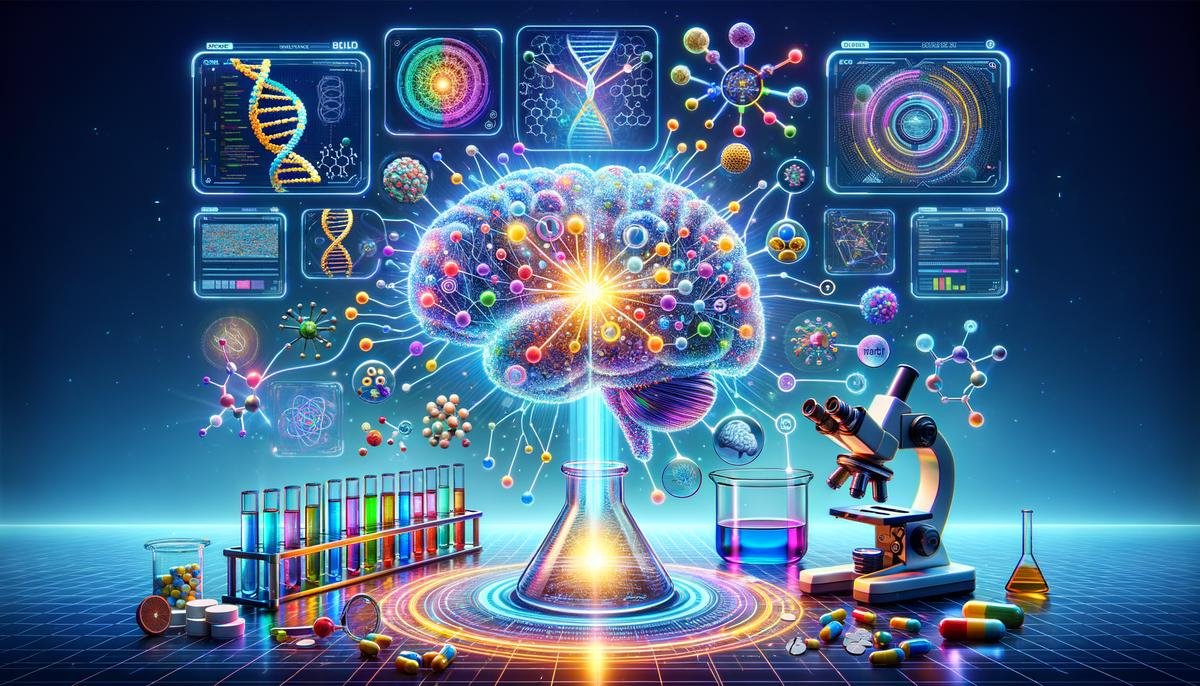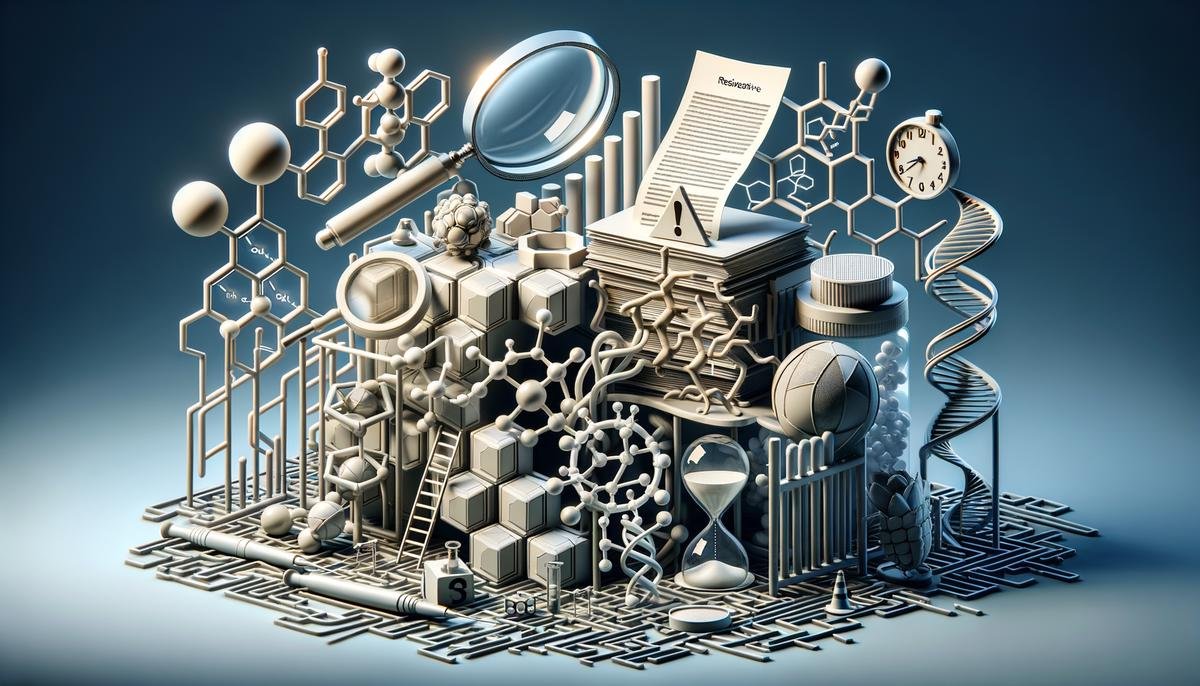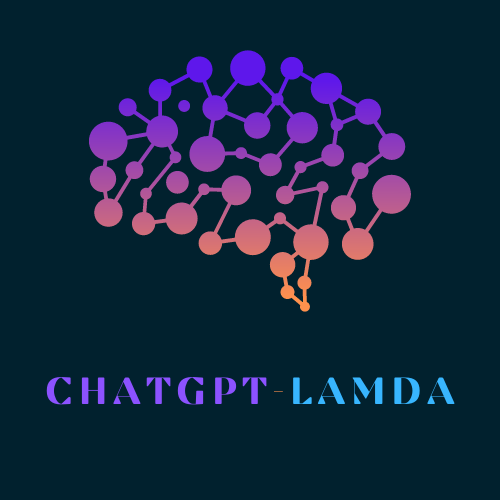At the intersection of technology and healthcare, a revolution is unfolding that promises to reshape the landscape of drug discovery. Atomwise stands at the forefront of this revolution, harnessing the power of artificial intelligence to pioneer advances that could drastically change how we approach the development of new medications. The implications of this evolution are profound, touching every facet of pharmacology and offering new hope for treatments that are faster, more effective, and potentially life-changing.
Understanding Atomwise and AI in Pharmacology
Atomwise: Revolutionizing Pharmaceutical Research with AI
In the fast-paced world of pharmaceutical research, finding the next big breakthrough in medicine is a complex and time-consuming process. Enter Atomwise, a company that’s changing the game with its innovative use of artificial intelligence (AI) in drug discovery. This isn’t just a small step forward—it’s a giant leap that could speed up the development of new medications and transform how we tackle diseases.
So, what’s the big deal with Atomwise? At its core, this company uses AI to predict how different molecules will react with target proteins in the body. Think of it like a super-smart program that can sift through millions of molecular structures and identify potential drugs much quicker than traditional methods. This is huge because the earlier stages of drug development, often referred to as “hit discovery” and “lead optimization,” can take years and a boatload of cash.
Atomwise’s method, known as structure-based virtual screening, isn’t just fast—it’s also incredibly precise. By analyzing the 3D structure of proteins at the atomic level, the AI can uncover potential drug compounds that might have been overlooked using conventional approaches. This precision means that researchers can focus on the most promising candidates, cutting down on wasted time and resources.
One of the standout features of Atomwise’s approach is its versatility. It’s not limited to one particular disease or type of medication. From cancer treatments to antibiotics and everything in between, Atomwise’s AI has the potential to make waves across the entire pharmaceutical landscape. The implications here are massive, especially when it comes to tackling diseases that have been difficult to treat with existing drugs.
Another point worth noting is the ability of Atomwise’s technology to breathe new life into old drugs. Through a process called drug repurposing, the AI can identify new uses for medications that are already on the market. This not only opens the door for treating conditions with fewer effective drugs but can also significantly reduce the time and cost it takes to bring a drug to patients who need it.
So, how successful is Atomwise in the real world? The company has already partnered with leading pharmaceutical companies and research institutes to put its AI to the test. Early results are promising, showing not only that the technology works but that it can genuinely expedite the drug discovery process. With a growing list of collaborations and successful case studies, Atomwise is on track to make an indelible mark on pharmaceutical research.
In a nutshell, Atomwise stands out in the pharmaceutical industry for its cutting-edge use of AI to make drug discovery faster, cheaper, and more effective. As the technology continues to improve and more successes are reported, Atomwise is poised to remain at the forefront of a revolution in how we develop medications. For researchers, patients, and healthcare providers alike, the work being done by Atomwise could mean a future where new treatments arrive on the scene quicker than ever before, offering hope where it’s needed most.

The Process of AI-Driven Drug Discovery
Exploring how Atomwise’s AI technology manages to knock down the traditional barriers in the drug discovery pipeline is like opening a door to a futuristic lab where precision and speed come together to pave a path for medical breakthroughs. At the heart of Atomwise’s innovation is a revolutionary approach that transcends conventional methods, ensuring a seamless and highly efficient drug development process. Let’s dive into the nuts and bolts of this process, emphasizing the critical aspects that make Atomwise not just another player but a game-changer in the pharmaceutical research arena.
Atomwise utilizes artificial intelligence to sift through a digital library of molecular structures. Imagine a library, but instead of books, it’s filled with molecules, each with the potential to be the next big drug. The AI, a master librarian, can scan millions of these molecules in the blink of an eye. This isn’t just about speed, though. The AI is trained to recognize which molecules could most effectively interact with specific proteins linked to diseases. It’s about making smart, informed decisions quickly.
This process of identifying promising molecules is known as virtual screening. Traditionally, this step required physical testing that could take years and a significant financial investment. Atomwise’s AI technology streamlines this process to a matter of days, drastically cutting down both time and cost. The immediate benefit here is clear: more potential drugs can be tested in less time, accelerating the pace at which life-saving treatments reach patients.
Another standout feature of Atomwise’s platform is its ability to predict the outcome of molecule-protein interactions with high accuracy. This predictive power comes from deep learning algorithms that have been ‘taught’ through the analysis of thousands of molecular structures and their impacts. This means that before any physical experiments are conducted, researchers have a clear picture of which molecules show the most promise, allowing them to focus their efforts where there’s the highest probability of success.
But Atomwise’s AI does more than just pick out potential winners; it provides valuable insights into the why and how of molecule-protein interactions. Understanding these dynamics is crucial for fine-tuning molecules to enhance their effectiveness or reduce possible side effects. Essentially, Atomwise’s technology offers a detailed road map for optimizing drug candidates, ensuring that only the most viable ones progress to the next stage of development.
Let’s not overlook the capacity of Atomwise’s AI to facilitate drug repurposing. In some cases, a molecule initially developed for one disease may show potential against another. This aspect of Atomwise’s work underscores the versatility and adaptability of its AI technology. By identifying new applications for existing drugs, Atomwise not only broadens treatment horizons but also offers a more cost-effective route to drug development, given that the safety profile of these drugs is often already well-established.
The collaboration factor is another pivotal piece of the puzzle. Atomwise doesn’t operate in a vacuum; it engages with pharmaceutical companies, academic researchers, and biotech firms worldwide. These partnerships are mutually beneficial, combining Atomwise’s AI prowess with the domain-specific expertise of its partners. Together, they accelerate the drug discovery process in a collaborative ecosystem that spans various disease areas and therapeutic targets.
In sum, Atomwise’s AI-driven approach is reshaping the landscape of pharmaceutical research. By leveraging artificial intelligence for molecule screening and analysis, Atomwise enhances the precision, speed, and cost-effectiveness of drug discovery. It’s a powerful example of how technology can be harnessed to conquer some of the most daunting challenges in medicine, paving the way for a future where treatments for even the most stubborn diseases are within reach.

Case Studies: Successes in Drug Discovery with Atomwise
The Journey of Atomwise’s AI: Fantastic Strides in Pharmaceutical Advances
Diving into the world of pharmaceuticals, Atomwise has become a standout name, renowned for its trailblazing use of artificial intelligence (AI) in drug discovery. The AI technology developed by Atomwise isn’t just a leap forward; it’s a quantum leap, transforming how the pharmaceutical industry approaches the discovery and development of new medications. Let’s explore some of the groundbreaking achievements Atomwise’s AI has accomplished so far.
Reducing Discovery Times Dramatically
One of Atomwise’s most noteworthy accomplishments is how its AI technology has slashed drug discovery times from years to mere days. Traditional methods of drug discovery are not just time-consuming; they’re akin to finding a needle in a haystack. Atomwise’s AI, with its unparalleled speed, sifts through this haystack with an efficiency that was previously unthinkable. This acceleration means that potential treatments reach clinical trials and, eventually, patients, much quicker than ever before.
Identification of Novel Drug Candidates
Atomwise’s AI has shown exceptional prowess in identifying novel drug candidates for diseases that are notoriously difficult to treat. By analyzing the structure of proteins associated with specific diseases, the AI can predict how different molecules will interact with these proteins. This capability has led to the identification of potential treatments for conditions such as Ebola and multiple sclerosis. The ability to pinpoint effective molecules without the need for extensive trial and error is a significant step forward in drug development.
Facilitating Breakthroughs in Multiple Therapeutic Areas
The versatility of Atomwise’s AI extends across multiple therapeutic areas, from oncology to infectious diseases. This broad applicability is a testament to the AI’s robust design, capable of tackling a diverse range of biological targets. For instance, Atomwise’s AI has been instrumental in discovering a potential treatment for a resistant form of malaria, showcasing its potential to impact global health crises positively.
Enhancing Target Validation Processes
Another area where Atomwise’s AI shines is in target validation, a critical step in confirming that a molecule will have the desired therapeutic effect. By accurately predicting molecule-protein interactions, the AI aids researchers in quickly determining which compounds are worth pursuing further. This process not only speeds up the development of viable drug candidates but also reduces the likelihood of costly failures down the line.
Spurring Innovations through AtomNet®
At the heart of Atomwise’s achievements is AtomNet®, the company’s proprietary deep learning technology. AtomNet® excels in modeling and analyzing the complex, three-dimensional structures of proteins, offering insights that drive the discovery of new drugs. This technology has sparked innovations in how scientists understand disease mechanisms and interactions at the molecular level, laying the groundwork for more effective treatments.
Building a Global Collaboration Network
Atomwise’s success isn’t just about technology; it’s also about collaboration. By partnering with leading pharmaceutical companies, academic institutions, and biotech firms worldwide, Atomwise has fostered a collaborative ecosystem that amplifies the impact of its AI technology. These partnerships leverage Atomwise’s AI capabilities to tackle a wide array of health challenges, demonstrating the technology’s capacity to benefit humanity on a global scale.
Conclusion
The strides made by Atomwise with its AI technology represent a transformative shift in pharmaceutical research. By dramatically reducing drug discovery times, identifying novel drug candidates, and facilitating breakthroughs across various diseases, Atomwise’s AI is not merely an advancement; it’s a revolution in the making. The future of medication development looks brighter than ever, with Atomwise’s AI leading the charge toward faster, more efficient, and more effective drug discovery processes. The achievements of Atomwise so far are just the beginning, with the promise of more groundbreaking successes on the horizon.

Challenges and Limitations of AI in Drug Discovery
While Atomwise and its AI technology have marked a significant leap forward in the realm of drug discovery, several challenges still loom large, hindering the full potential AI holds in revolutionizing this field. As we continue to navigate the intricate process of integrating artificial intelligence into pharmaceutical research, these hurdles demand our attention and action.
Data Quality and Quantity:
For AI models like Atomwise’s to accurately predict molecule-protein interactions, they require vast amounts of high-quality data. However, the accessibility to such comprehensive datasets can be challenging. The data must not only be abundant but also accurate, diverse, and representative of real-world conditions. In many cases, the data available is fragmented, incomplete, or biased towards certain diseases and molecule types, limiting the AI’s learning potential and applicability across a wider spectrum of drug discovery endeavors.
Computational Resources:
The processing power required to run sophisticated AI algorithms is immense. Analyzing millions of potential molecule-protein interactions across numerous diseases necessitates access to considerable computational resources. Not every institution or company involved in drug discovery possesses the infrastructure to support such demanding computational tasks, creating a barrier to adopting and leveraging AI technologies fully.
Regulatory and Ethical Concerns:
As AI begins to play a more crucial role in drug discovery, regulatory bodies face the challenge of establishing guidelines that ensure safety and efficacy without stifling innovation. The dynamic and opaque nature of AI algorithms can make it difficult for regulators to assess and approve new drugs developed with AI assistance. Moreover, ethical considerations concerning data privacy, cybersecurity, and the potential for biased AI predictions must be meticulously navigated.
Integration with Existing Processes:
The pharmaceutical industry, with its long-standing traditions and methods, faces challenges in integrating AI technologies into its existing workflows. The transition involves not just the adoption of new tools but also a cultural shift towards embracing data-driven decision-making and continuous learning systems. Moreover, the complexity of drug discovery tasks can vary significantly, requiring flexible AI solutions that can be customized and scaled according to specific project needs.
Interpreting AI Decisions:
One of the most significant challenges in utilizing AI for drug discovery is understanding and interpreting the ‘how’ and ‘why’ behind its predictions. AI algorithms, especially those based on deep learning, are often seen as ‘black boxes’ that provide outcomes without explainable reasoning. This lack of transparency can be a hindrance in validating AI-generated hypotheses and gaining trust from researchers and regulators accustomed to traditional, interpretable methods.
Collaboration and Access:
Finally, the full benefit of AI in drug discovery can only be realized through widespread collaboration and access. Sharing data, research findings, and AI models across institutions and borders can accelerate the pace of innovation. However, issues such as intellectual property rights, data ownership, and competitive advantage can impede the open exchange of information necessary for collective progress.
In conclusion, while AI technologies like Atomwise signify a groundbreaking advancement in drug discovery, addressing these challenges is crucial for unlocking their complete transformative potential. Overcoming these barriers requires a concerted effort from researchers, industry leaders, regulators, and policymakers to foster an environment that nurtures innovation while ensuring safety, efficacy, and fairness in the quest for new treatments.

The Future of AI in Pharmaceutical Research
The journey of drug discovery is like a complex puzzle. With advancements in AI, scientists and researchers are finding themselves equipped with better tools to solve this puzzle more efficiently than ever before. But what does the future hold for AI in advancing drug discovery? Let’s deep-dive into aspects that are paving the way for a revolution in medical breakthroughs.
Tackling Challenges Head-On
Despite the significant strides made by platforms like Atomwise, challenges in drug discovery remain. AI is now gearing up to address these head-on, focusing on enhancing data quality and quantity. As the backbone of AI-driven research, the more accurate and extensive the data, the better AI systems can learn and predict. To ensure success, future efforts will likely intensify in gathering diverse, high-quality datasets from varied sources, including genomic sequences, chemical compound libraries, and clinical trial results.
Another critical area is the expansion of computational resources. AI and machine learning models, especially those as sophisticated as AtomNet®, require immense computational power. The future will see a surge in investment in high-performance computing facilities and cloud-based solutions, enabling researchers to run complex models more swiftly and efficiently.
Regulatory and Ethical Pathways
As AI continues to disrupt the norm in drug discovery, regulatory bodies and ethical frameworks will play catch-up. There’s a broad consensus that ensuring patient safety and data privacy is paramount. Future advancements will need to navigate these waters carefully, shaping a framework where innovation thrives without compromising ethical standards or patient confidentiality. The FDA and other global regulatory entities are beginning to adapt, paving the way for AI-driven drugs and therapies to move more smoothly from the lab to the clinic.
Integration and Interpretation
The integration of AI into traditional drug discovery processes raises questions about compatibility and the seamless transition of information. Future advancements in AI will likely focus on creating more intuitive platforms that can seamlessly mesh with existing drug development pipelines, ensuring that AI’s predictive capabilities can be fully leveraged without bottlenecks.
Moreover, the interpretation of AI decisions in drug development is a fascinating frontier. Future AI systems will not only need to predict and identify but also “explain” their rationale in a way that’s comprehensible to human researchers. This doesn’t just aid in decision-making but also in building trust in AI systems amongst the scientific community.
Collaboration: The Key to Unlocking Potential
Atomwise’s model of global collaboration has underscored the importance of shared knowledge and resources in drug discovery. The future is likely to witness an expansion of these networks, involving more stakeholders from across the spectrum, including academia, biotech startups, pharmaceutical giants, and even patients. Such collaboration can accelerate the identification of targets, optimization of drug candidates, and initiation of clinical trials, making the drug discovery process more efficient and inclusive.
Conclusion
As we glance towards the horizon, the role of AI in drug discovery appears not just promising but revolutionary. With the potential to shorten drug development timelines, identify novel drug candidates, and tackle diseases from multiple therapeutic areas, AI stands as a beacon of hope. However, this vision of the future isn’t without its hurdles. Overcoming challenges related to data quality, computational resources, ethical concerns, and regulatory approval will be pivotal in realizing the full potential of AI in advancing drug discovery.
In essence, the journey of AI in drug discovery is a testament to human ingenuity and collaboration, a path marked by both challenges and incredible opportunities. As the field evolves, so too will our ability to fight diseases, offering hope for new treatments and cures that were once thought to be beyond our reach. The intersection of AI and pharmacology not only aims to revolutionize drug discovery but also to forge a future where diseases are no longer seen as insurmountable adversaries but challenges that can be overcome.

The ambition of Atomwise reflects a broader shift in the pharmaceutical industry towards embracing the untapped potential of AI. With its ability to streamline the drug discovery process, identify novel candidates for challenging diseases, and repurpose existing drugs for new uses, AI is not just an accessory to traditional methods—it’s becoming the backbone of a new era in medical research. This transformative approach fosters hope, drives innovation, and could very well lead us into a future where the battle against disease is waged not just with molecules, but with the power of intelligent machines.



